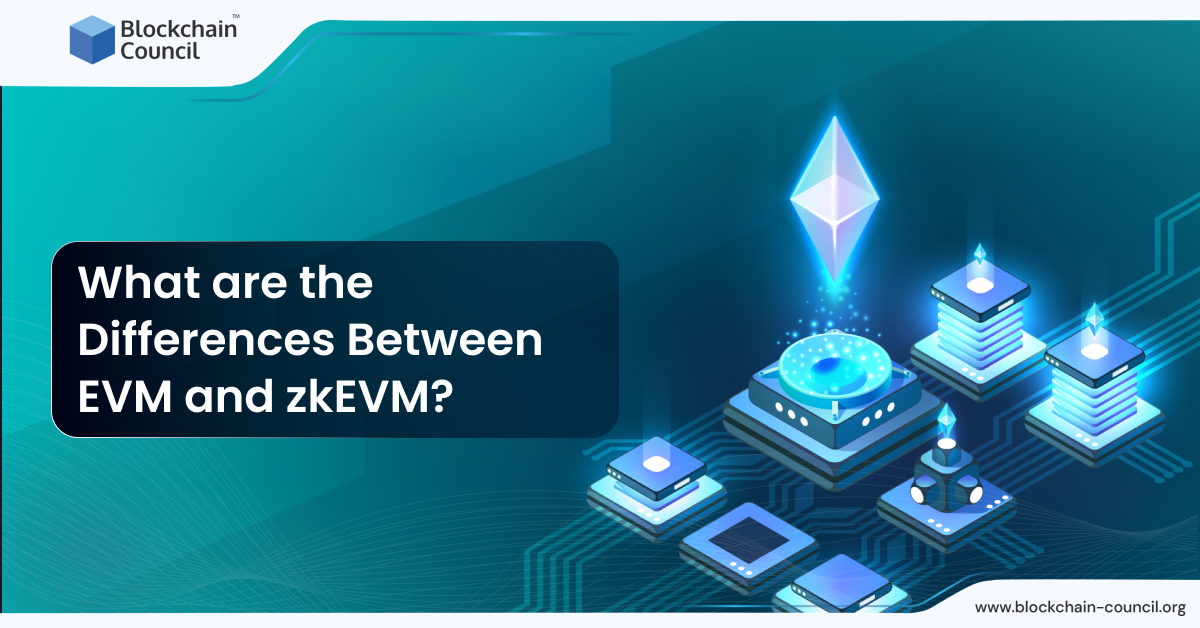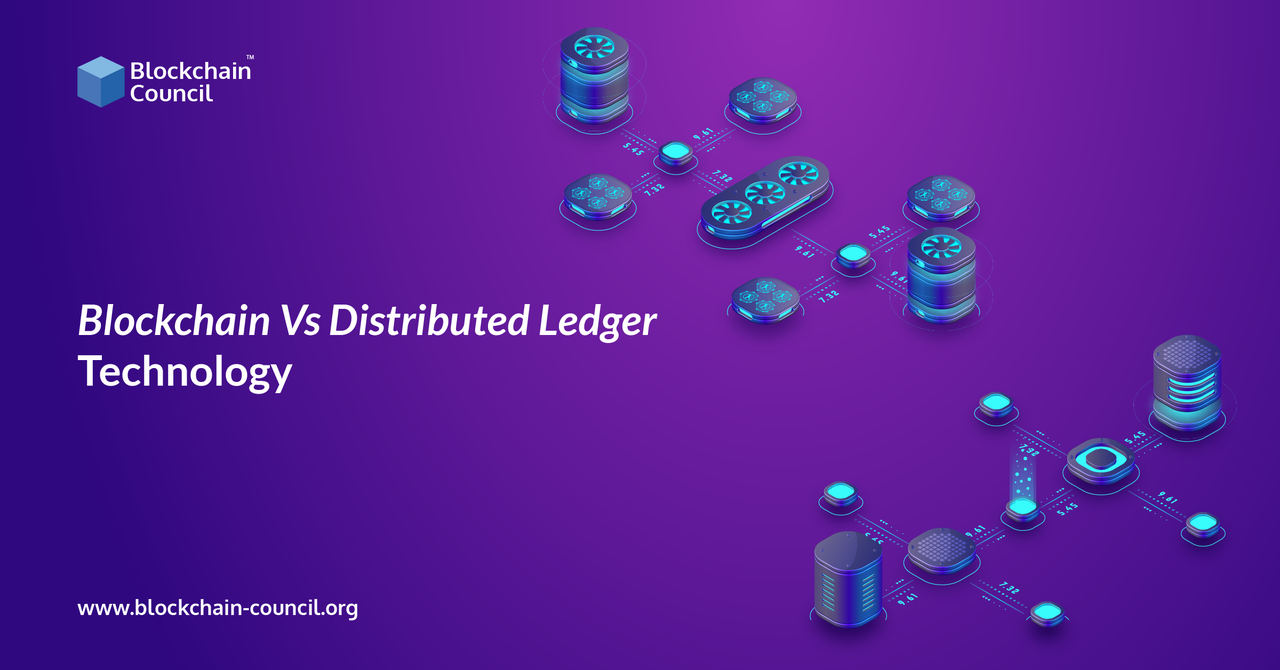
- Blockchain Council
- November 02, 2023
Summary
- The article discusses the key differences between Ethereum Virtual Machine (EVM) and zkEVM in the context of Blockchain technology.
- EVM is a decentralized computer that executes smart contracts within the Ethereum network, enabling various decentralized applications (DApps).
- zkEVM is an upgrade that brings privacy and scalability to Ethereum using zero-knowledge proofs.
- One major difference is that zkEVM can process transactions faster than EVM due to off-chain execution, reducing transaction costs.
- Data availability in EVM is on-chain, while zkEVM uses off-chain data processing, improving scalability and efficiency.
- zkEVM offers interoperability with Ethereum’s smart contracts and existing DApps, making it easier for developers to transition from EVM.
- Security in EVM is based on proof-of-stake (PoS) consensus, while zkEVM enhances security and finality using zkRollups.
- zkEVM moves smart contract execution off-chain, significantly speeding up the process, and incorporates zero-knowledge proofs for privacy.
- The execution environment and opcodes differ between EVM and zkEVM, with zkEVM using complex cryptographic techniques for proof generation.
- The transition from EVM to zkEVM represents a significant step towards solving scalability and privacy issues in Ethereum, ushering in a new era of Blockchain technology.
Introduction
In the rapidly evolving landscape of Blockchain technology, the Ethereum Virtual Machine (EVM) has been a cornerstone for developers, enabling the creation of myriad decentralized applications (DApps). However, as the ecosystem develops, the limitations of EVM in terms of privacy and scalability have become more apparent. So, what’s the solution? It is called zkEVM.
It is a promising upgrade leveraging zero-knowledge proofs to bring about a new era of privacy and scalability to the Ethereum network. So what is the difference between EVM and zkEVM? Basically, zkEVM improves EVM in many ways. But how?
In this article, we will discuss the key differences between EVM and zkEVM. We will dissect their differences across various dimensions including transaction throughput, data availability, interoperability, and more.
As we stand at the cusp of a Blockchain revolution, understanding these technological advancements is paramount for both the curious and the professional. So, let’s get started to understand the key distinctions between EVM and zkEVM. But before we start:
What is EVM?
At its core, EVM is a decentralized computer that executes smart contracts within the Ethereum network. Unlike a physical machine, it operates as software, meticulously validating transactions and ensuring the seamless execution of smart contracts. These smart contracts are self-executing code snippets, embodying the agreements between parties on the Ethereum platform.
When a transaction occurs on the Ethereum network, it triggers a series of operations within the EVM. First, the transaction is verified for its authenticity and validity. Once confirmed, the EVM processes the transaction, executing the corresponding smart contract code. This execution is replicated across all nodes in the Ethereum network, ensuring consensus and immutability.
EVM serves as the linchpin for developers aiming to create decentralized applications, also known as DApps. These applications, ranging from decentralized finance (DeFi) platforms to gaming and supply chain management solutions, rely on the EVM’s robust computational capabilities. Its ability to execute complex code autonomously empowers developers to innovate, creating a plethora of decentralized solutions that redefine various industries.
EVM’s significance cannot be overstated. It forms the backbone of Ethereum’s unparalleled flexibility and functionality. Its Turing-complete nature enables developers to implement a wide array of algorithms and business logic, making Ethereum a fertile ground for creative exploration and problem-solving. EVM’s versatility has contributed significantly to Ethereum’s prominence, making it a preferred choice fo
What is zkEVM?
Unlike the standard EVM, zkEVM brings privacy and scalability to the Ethereum network. It enables smart contracts to be executed without revealing all their details. This is achieved through a cryptographic technique called zero-knowledge proofs.
With zkEVM, transactions and computations can be verified without disclosing the underlying data. It’s like sharing the result of a complex math problem without revealing the steps taken to solve it. This enhances security and confidentiality.
But zkEVM doesn’t stop at privacy; it tackles the scalability issue plaguing many Blockchain networks, Ethereum included. Here’s how: zkEVM utilizes zk-Rollups, a technique bundling multiple transactions into a single succinct proof. This compact representation drastically reduces the computational load on the network, allowing it to process numerous transactions simultaneously.
Moreover, zkEVM addresses the scalability issues that have plagued Ethereum. By using zk-Rollups, it bundles multiple transactions into a single proof, reducing the network’s load and increasing transaction speed. This innovation significantly improves the user experience and lowers transaction costs.
For developers, zkEVM provides a robust framework for building decentralized applications (dApps) with enhanced privacy features. It opens doors to various use cases, from financial services to supply chain management, where data confidentiality is crucial.
As Blockchain technology continues to evolve in 2024, it’s imperative to grasp the intricate differences between the Ethereum Virtual Machine (EVM) and zkRollups with EVM compatibility (zkEVM). This detailed analysis will equip both beginners and professionals with a profound understanding of these critical components.
When people inquire about “What is EVM?” or “What is zkEVM?‘‘ They’re seeking insight into these technologies’ potential impact on the Blockchain world. So, let’s understand the key differences between the two!
Differences Between EVM and zkEVM
| Aspect | EVM | zkEVM |
| Transaction Throughput & Scalability | Slower processing, full execution on-chain | Faster, off-chain execution and proof verification |
| Data Availability | On-chain storage, potential bottlenecks | Off-chain data model, enhanced scalability |
| Interoperability & Integration | Requires bridging solutions, complex | Backward compatibility, streamlined integration |
| Security & Finality | PoS consensus mechanism, reduced risk | zkRollups, enhanced security, faster finality |
| Privacy Features & Smart Contracts | On-chain execution, limited privacy | Off-chain execution, zero-knowledge proofs for privacy |
| Execution Environment | On-chain execution, resource-intensive | Off-chain “rollup,” faster and less load on mainnet |
| Proof Generation | Simpler on-chain execution | Complex, off-chain with cryptographic techniques |
| Opcodes & State Tree | Standard opcodes and state tree | Different opcodes, state tree for zk proofs |
1. Transaction Throughput and Scalability
EVM (Ethereum Virtual Machine) is a runtime environment for executing smart contracts on the Ethereum Blockchain. In contrast, zkEVM (zero-knowledge EVM) is a new type of EVM that leverages zero-knowledge proofs to verify the execution of smart contracts off-chain and then post a proof of their validity on-chain.
One of the most significant disparities between EVM and zkEVM is processing speed. zkEVMs can process transactions much faster than EVMs because they only need to verify the validity of transactions rather than executing them in full. This is due to zkEVM’s innovative approach of off-chain execution.
Moreover, zkEVMs significantly reduce transaction costs by posting only the proof of validity on-chain, sparing the need to include full transaction data. This cost-effective aspect makes zkEVMs an attractive choice for users.
Scalability is another area where zkEVMs shine. By processing transactions off-chain and posting only the proof of validity on-chain, zkEVMs effectively address Ethereum’s scalability challenges. This innovation is pivotal for the Blockchain ecosystem’s growth.
2. Data Availability: On-Chain vs. Off-Chain
In EVM, data availability relies on an on-chain approach. This means all data must be stored on the Ethereum Blockchain, which can be a bottleneck for applications with extensive data requirements. As the chain grows, managing data on-chain becomes increasingly challenging.
In contrast, zkEVM leverages an off-chain data model. Most of the data processing occurs off the Ethereum mainnet. This approach enhances scalability and efficiency, as only essential information is anchored on-chain. This ensures that zkEVM can effectively handle a broader spectrum of applications, from DeFi protocols to NFT platforms, without experiencing severe data bottlenecks.
3. Interoperability and Integration
EVM’s interoperability with other Blockchains and platforms primarily relies on bridging solutions. These solutions, while effective, add complexity to the development process and can introduce additional risks.
zkEVM simplifies interoperability by providing inherent compatibility with Ethereum’s smart contracts and existing dApps. Developers can port their projects from EVM to zkEVM with relative ease, thanks to its backward compatibility. This streamlines the integration process, reducing friction and promoting broader adoption.
4. Security and Finality
EVM’s security is anchored in the proof-of-stake (PoS) consensus mechanism, which has proven to be robust over the years. PoS brings a different set of security considerations compared to PoW. EVM on PoS benefits from reduced risk of 51% attacks. The security profiles of these two technologies may vary due to their different consensus mechanisms.
zkEVM offers enhanced security and faster transaction finality by employing zkRollups. These rollups validate transactions off-chain and then provide a succinct proof on-chain, reducing the need for extensive computation on the mainnet. This approach not only improves security but also accelerates transaction confirmation, offering a better user experience.
5. Privacy Features and Smart Contract Execution
While EVM is known for executing smart contracts on-chain, which can lead to slower transaction processing, zkEVM adopts a different approach. zkEVM moves the bulk of smart contract execution off-chain, significantly speeding up the process. Moreover, zkEVM incorporates zero-knowledge proofs to enhance privacy. This means users can enjoy confidential transactions and data protection, which is not a native feature of EVM.
6. Execution Environment
One of the core technical distinctions lies in the execution environment for smart contracts. EVM executes smart contracts on the Ethereum Blockchain itself, which means that the contract’s code is run on-chain. This, however, can be resource-intensive and contribute to the scalability challenges faced by Ethereum.
In contrast, zkEVM takes a different approach. It executes smart contracts in a distinct off-chain environment, often referred to as a “rollup.” This environment is crucial for the execution of zero-knowledge proofs, as it allows for complex computations to occur away from the main Ethereum network. This separation significantly speeds up transaction processing and reduces the computational load on the Ethereum mainnet.
7. Proof Generation
One of the central technical components of zkEVM is the generation of zero-knowledge proofs. These proofs are vital for zkEVM’s off-chain smart contract execution and transaction validation. The process of generating these proofs is complex and computationally intensive. It involves advanced cryptographic techniques, which add an extra layer of security and privacy to zkEVM transactions.
The generation of zero-knowledge proofs requires significant computational resources and cryptographic expertise. This sets zkEVM apart from EVM, where smart contract execution is more straightforward and occurs directly on the Ethereum mainnet.
8. Opcodes and State Tree
zkEVM may implement a different set of opcodes compared to EVM. For instance, the SELFDESTRUCT opcode is replaced with a SENDALL opcode in zkEVM. This change reflects the fundamental shift in how smart contracts are executed and validated in zkEVM.
Additionally, zkEVM may utilize a different state tree implementation than EVM. This divergence is necessary to support zero-knowledge proofs efficiently. The state tree represents the current state of the Blockchain, and zkEVM’s adaptation ensures that it can seamlessly incorporate zk proofs into its operation.
Here are some more examples of EVM opcodes that are different in zkEVMs:
- EXTCODEHASH: This opcode returns the hash of the contract bytecode from the zkEVM state tree without checking if the account is empty.
- DIFFICULTY: This opcode returns 0 instead of a random number as in the EVM.
- BLOCKHASH: This opcode returns all previous block hashes instead of just the last 256 blocks. BLOCKHASH is the state root at the end of a processable transaction and is stored on the system smart contract.
- NUMBER: This opcode returns the number of processable transactions.
Also Read- How Does zkEVM Work?
Conclusion
The discourse around EVM and zkEVM isn’t merely a technical discussion but a glimpse into the future of Blockchain technology. In this article we answered the burning question, “What are the differences between EVM and zkEVM?”. The evolution from EVM to zkEVM signifies a monumental stride towards solving the longstanding issues of scalability and privacy on the Ethereum network. As we explored the nuanced differences between EVM and zkEVM, the latter’s potential in propelling Ethereum to new heights of scalability, privacy, and efficiency became evident.
The advent of zkEVM doesn’t just promise a better Ethereum; it beckons a new era of Blockchain technology where the true potential of decentralized applications can be realized. As developers, stakeholders, and users, the onus is on us to embrace, contribute to, and propel this innovative technology forward, steering the Blockchain ship into uncharted but promising waters.
Frequently Asked Questions
What is EVM?
- EVM stands for Ethereum Virtual Machine.
- It is a decentralized computer within the Ethereum network that executes smart contracts.
- Smart contracts are self-executing code snippets that facilitate agreements on the Ethereum platform.
- EVM’s execution is replicated across all nodes in the Ethereum network for consensus and immutability.
What is zkEVM?
- zkEVM, or zero-knowledge EVM, is an upgrade to the Ethereum Virtual Machine (EVM).
- It leverages zero-knowledge proofs to enhance privacy and scalability within the Ethereum network.
- zkEVM allows for the execution of smart contracts without revealing all their details through cryptographic techniques.
What are the differences between EVM and zkEVM?
- Transaction Throughput: zkEVM processes transactions faster and at lower costs due to off-chain execution and minimal on-chain data.
- Data Availability: EVM uses on-chain data, while zkEVM employs an off-chain data model, enhancing scalability.
- Interoperability: zkEVM is backward compatible with Ethereum, simplifying integration.
- Security: zkEVM enhances security and transaction finality using zkRollups.
- Privacy and Execution: zkEVM executes smart contracts off-chain, ensuring privacy through zero-knowledge proofs.
- Proof Generation: zkEVM involves complex zero-knowledge proof generation, a feature not present in EVM.
- Opcode Differences: zkEVM may implement different opcodes and state tree structures to support zero-knowledge proofs efficiently.
What is the primary purpose of zkEVM?
- The primary purpose of zkEVM is to enhance privacy and scalability in the Ethereum network.
- It achieves this by executing smart contracts off-chain with the help of zero-knowledge proofs.
- zkEVM also reduces transaction costs, improves interoperability, and offers enhanced security and finality.





































































 Guides
Guides News
News Blockchain
Blockchain Cryptocurrency
& Digital Assets
Cryptocurrency
& Digital Assets Web3
Web3 Metaverse & NFTs
Metaverse & NFTs
